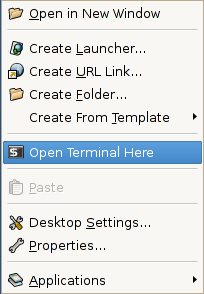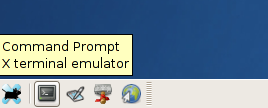bash shell¶
using the command line¶
To access the command line from your NX session, open a terminal window: right-click on the background, and select ‘Open Terminal Here’:
Alternatively, there is a shortcut icon in the lower left of the screen:
locating software¶
Most software is located in /usr/local. Use the ‘which’ command to locate if (and where) a progam is installed, for example:
$ which matlab
bash shell script¶
A shell script is a series of commands saved to a file for later execution.
You can create a script with a text editor. Text editors available on the cluster include:
gedit: simple editor with a graphical interface
nano: simple editor with a curses-based interface
emacs: advanced editor with a graphical interface
vi: advanced editor with a text interface
Below is an example of a script that prints the date, and then sleeps 20 seconds.
Start a text editor:
$ nano
Enter the following text, and save as ‘simple.sh’:
#!/bin/shdatesleep 20Make the script executable:
$ chmod a+x simple.sh
Run the command at the shell prompt:
$ ./simple.sh
bash iteration¶
A common use of shell programming is to perform a task multiple times, iterating over a list.
In this example, we use a ‘for’ loop to run the ‘echo’ command 5 times. As a result, the value of ‘i’ is printed (echo’d) to the screen, where i=1, i=2, i=3, i=4 and i=5. The for loop is terminated with the ‘done’ statement.
You may copy and paste the lines below into a terminal window. Alternatively, copy them into a file, and run it as a shell script:
for i in 1 2 3 4 5; do
echo "$i"
done
The ‘seq’ command prints a sequence of numbers, and has options to define the increment, pad with zeros, etc. In this example, we evaluate the numbers 0 to 20 by increments of 4:
j=0
for i in `seq 0 4 20`; do
# print value of i
echo "i is $i"
# add i+j
((j = $j + $i))
# print value of j
echo "j:$j"
done
you may copy and paste the code directly into a terminal window, or copy them into a file, and run it as a shell script. To learn more about seq, run ‘man seq’ (to quit the ‘man’ command, type ‘q’).
common commands¶
Below are some common unix commands that you can type from a terminal window
Change Working Directory:
cd go to your login (home) directory
cd ~username go to username's login (home) directory
cd .. go up one directory level from here
cd ../.. go up two directory levels from here
cd /path/to/dir go to <dir>
cd path/to/dir go to path relative to here (no leading slash).
Make a directory:
mkdir dirname make a directory identified by 'dirname'
List files:
ls list contents of current directory
ls -a include files with "." (dot files)
ls -l list contents in long format
ls -rt list contents, sort by time modified in reverse order
Determine a file type:
file filename show the content type of 'filename'
Display file contents:
cat filename show contents of filename
less filename show contents of filename one page at a time
head filename show first 10 lines of filename
tail filename show last 10 lines of filename
head -50 filename show first 50 lines of filename
Move (or rename) a file or directory:
mv srcfile destfile rename srcfile to destfile
mv srcfile destdir move a file into the destdir directory
mv srcdir destdir rename srcdir to destdir; if destdir exists, then move to srcdir to destdir
mv -i srcdir destdir same as above, but prompt before overwriting
Copy a file or directory:
cp srcfile destfile make a copy of srcfile called and call it destfile
cp srcfile destdir make a copy of srcfile, and place it in the destdir directory
cp -R srcdir destdir copy srcdir (and contents) to destdir
cp -i src dest same as above, but prompt before overwriting
Remove a file:
rm filename remove (delete) filename
rmdir dir remove an empty directory
rm -r dir remove a directory and its contents
rm -i filename remove filename, but prompt before deleting
Redirection:
cmd1 | cmd2 "pipe" output from cmd1 to input of cmd2
command > filename direct output of command to filename, replacing contents of filename
Search files for text string:
grep string filename show lines containing string in filename
grep string filelist show lines containing string in any file in filelist
grep -v string filelist show lines not containing string
grep -i string filelist show lines containing string, ignore case
grin pattern directory recursive through directory; show lines of all ascii files that match pattern
Limit search with grep:
ls | grep pattern show output of ls that matches pattern
Search directories for file name:
find . | grep pattern recurse through current directory; show file names that match pattern
find ~ -name "*.nii" recurse through home directory; show file names that end with '.nii'
Compress files or directories:
See: data compression
Show running process:
pgrep processname show processes called 'processname'
ps -ef | grep username show all processes owned by username
cssh pgrep processname show jobs called 'processname' on all workstations
cssh ps -ef | grep usrname show jobs owned by username on all workstations
Terminate a process that you own (running with your username):
ctrl-C kill foreground process
kill pid# kill process identified by pid number (see 'ps' above)
pkill processname kill process identified by 'processname' (see 'pgrep' above)
Show system resources:
nxload show resources available on all workstations
top show process information on this system
top -u username show process information of username on this system
User information:
finger username show information about username
w show who is logged in to this system
Show Sun Grid Engine queue:
qstats | less display SGE queue information one page at a time
Change password:
See: change password
See common commands


